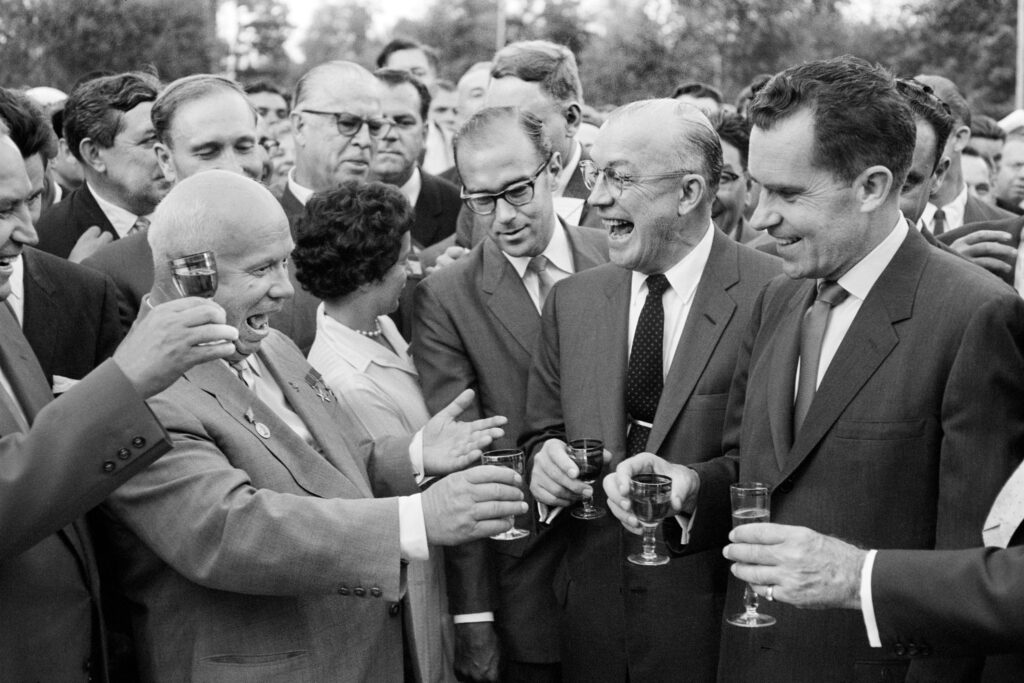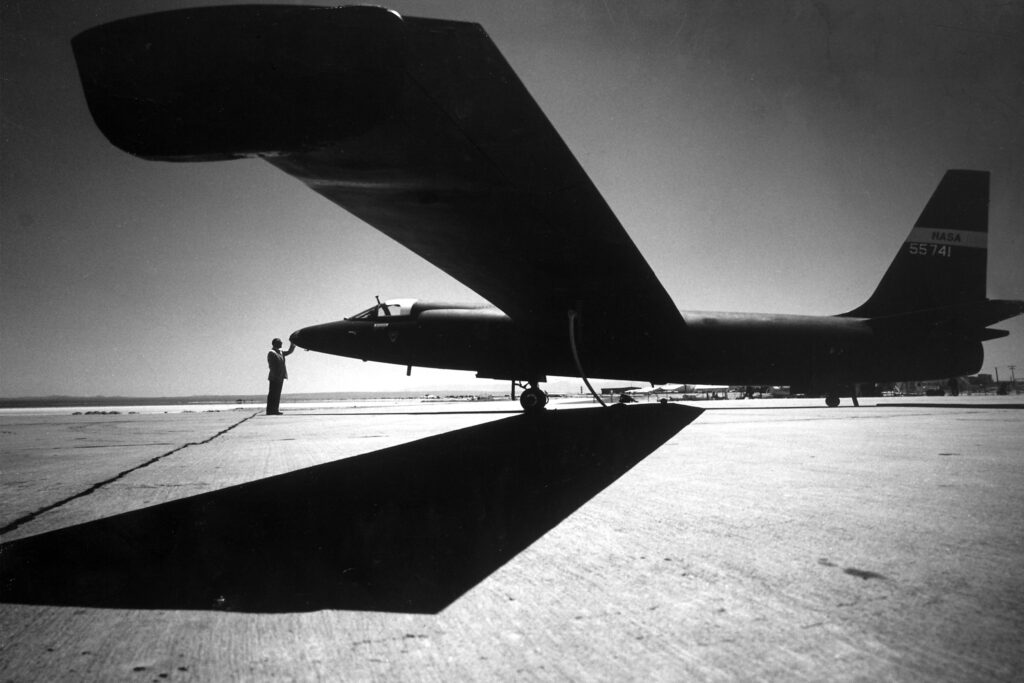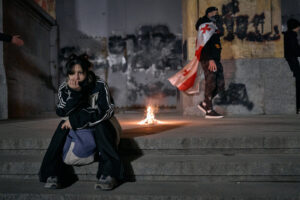Whose Fault Was the Cold War?

The Cold War—the epic struggle between the United States and the Soviet Union over the globe’s resources, people, and future—shaped, and reshaped, everything. From geopolitics to public discourse to social welfare to the films, television, and music that people all over the world consumed, the Cold War defined life in the twentieth century’s second half.
Unsurprisingly, a phenomenon of such importance has been the subject of a large and expansive historiography; since the Cold War began, historians have been trying to explain why, exactly, it broke out. Most American scholars initially blamed the Cold War on the Soviet Union. Stalin, these historians affirmed, was a rapacious ideologue dedicated to global revolution, and it was he who was responsible for US-Soviet tensions. In the 1960s, however, a group of scholars led by the University of Wisconsin’s William Appleman Williams challenged this “traditionalist” perspective. Under the banner of “revisionism,” they argued that, far more than Stalin, it was the United States’ search for export markets, as well as the American state’s close relationship with its capitalist class, which explains the Cold War.
From the 1970s to the 1990s, the next generation of historians embraced a new, “post-revisionist” synthesis that combined elements of both schools’ accounts. On one hand, as John Lewis Gaddis, the most influential post-revisionist, admitted, he and his colleagues were very influenced by the traditionalists. Similar to the traditionalists, post-revisionists argued “that American officials worried more about the Soviet Union than about the fate of capitalism in designing the policy of containment,” claimed “that Soviet expansionism was the primary cause of the Cold War,” and contended “that American allies welcomed the expansion of US influence as a counterweight to the Russians.” On the other hand, and similar to the revisionists, the post-revisionists maintained that the United States deployed “economic instruments to achieve political ends,” emphasized “the absence of any ideological blueprint for world revolution in Stalin’s mind,” agreed that sometimes the US government “exaggerate[d] external dangers for the purpose of achieving certain internal goals,” and acknowledged “that there was in fact an American ‘empire.’” Post-revisionist scholarship dominated the historiography on the Cold War for decades.
Things began to change in the mid-2000s. Under the influence of Odd Arne Westad’s paradigm-shifting The Global Cold War: Third World Interventions and the Making of Our Times (2005), which sought to refocus historians’ attention on the Cold War in the “Third World,” scholars in effect stopped looking into the question of who was responsible for the US-Soviet struggle. Instead, they turned toward analyzing, first, how it played out in the Global South; second, how non-American actors shaped world events; and, third, how non-state actors, such as nongovernmental organizations, multinational corporations, and radical political groups, reacted to and interacted with the Cold War. Unlike previous generations of Cold War historians, these “international” and “transnational” scholars never coalesced into a coherent school centered on concrete causal claims but were instead united by a common project: to show how non-American and non-state actors experienced and defined the Cold War.
Nevertheless, the question of responsibility has recently reemerged as a major one for historians. Disenchantment with the fantasies of borderless globalization that characterized the 1990s and 2000s, the success of the über-nationalist Donald Trump, and the emergence of China as a threat to US power in East Asia have all reignited scholars’ interest in great-power politics broadly and cold wars in particular. Indeed, in the last two years two eminent historians, Columbia University’s Anders Stephanson and Johns Hopkins University’s Sergey Radchenko, have released books that consciously recenter the United States and the Soviet Union—and the question of responsibility—in Cold War history.
Taken together, Stephanson’s American Imperatives: The Cold War and Other Matters and Radchenko’s To Run the World: The Kremlin’s Cold War Bid for Global Power, demonstrate one thing above all: the Cold War was, to borrow Stephanson’s phrasing, a “US project”—it was, ultimately, an American choice. This fact has crucial implications for US foreign policy in the twenty-first century, an era in which the United States faces China, a great power that, like the Soviet Union before it, has designs on its near abroad. To put it bluntly, the future of international relations will be shaped by Americans, who either will try to prevent the People’s Republic from achieving dominance in its potential sphere of influence or will accept the realities of Chinese power. If Americans don’t choose wisely, a third world war might very well break out.
To most people, the “Cold War” is a transparent term that refers to a discrete era—the period between 1947 and 1989, during which geopolitics was structured around a US-Soviet antagonism that never erupted into an outright superpower war.
Stephanson, however, rejects this common sense understanding. According to him, a “cold war” is not simply a conflict in which both sides refuse to engage in a “hot” war with the other. Rather, it is a unique form of geopolitical antipathy that is defined by “absolute hostility”—at least one side of a cold war must view the other as fundamentally illegitimate, unworthy of genuine diplomatic engagement. Crucially, cold wars aren’t always two-way streets, and in Stephanson’s telling, the Cold War of the twentieth century was a US-driven affair: it was the Americans who decided that the Soviet project was illegitimate and could not be countenanced. Americans, in short, turned the cold war switch on. The question, of course, is why—why did a group of leaders who had only recently been allied with the Soviet Union all of a sudden decide that they could no longer deal with it?
Stephanson offers a two-pronged answer to this question. First, the Cold War had practical benefits for American “internationalists,” those liberal elites making US foreign policy in the late 1940s and early 1950s who wanted the United States to become the prime global power, a goal that starkly departed from previous American history. Between the late eighteenth century, when George Washington warned his countrymen against entangling themselves in the political and military affairs of Europe, and the US entry into World War I, when Woodrow Wilson committed troops to a European war, the United States mostly remained confined to the Western Hemisphere, with the acquisition of Pacific territories—the Philippines and Guam—after the Spanish-American War of 1898 being the exception that proved the rule. Even after World War I, US troops returned home as many elite and ordinary Americans concluded that intervening in a European conflict had been a mistake.
While World War II appeared to change all that by entangling the United States in a genuinely global conflict, policymakers were anxious that after the defeat of Germany and Japan the traditional American commitment to the Western Hemisphere would rapidly reassert itself. In fact, in the war’s aftermath, a demobilization fever swept the United States, with Americans, exhausted by years of service and sacrifice, wanting to do nothing more than return to normalcy. Declaring the Soviet Union a gens non grata–an existential threat to humanity analogous to Nazi Germany–was therefore part of an elite strategy to ensure the United States remained heavily involved in world affairs. And it didn’t hurt, of course, that the elites who made these claims, themselves scarred by two world wars, believed what they were saying.
Engendering anxieties about the Soviet Union was also a means to persuade ordinary Americans that the United States needed to mobilize its society for a prolonged conflict. The Cold War, in short, enabled the enormous defense budgets and armed forces of which Americans were typically suspicious. It also had the political benefit of making criticism of US foreign policy anathema, framing critique as defeatist and anti-American. The Cold War transformed global interventionism and domestic militarism into common sense.
Second, the very concept of a “cold war” fit in well with traditional American ideology. Since the nation’s founding, American culture had been permeated with a messianic fervor that insisted the United States was the embodiment of Progress and Freedom. This fervor led Americans to repeatedly frame politics in binary terms. There’s not that much of a leap, Stephanson archly notes, from Patrick Henry’s “give me liberty or give me death” to “better dead than red” (or, one might add, George W. Bush’s “either you are with us, or you are with the terrorists”). In effect, Americans were primed to understand the Soviet Union as the antithesis of their own nation.
For these reasons, by the early 1950s elite and ordinary Americans alike had identified the Soviet Union as an abnormal country with which they could not reach legitimate agreements.
Stephanson’s most novel argument, however, is his claim that the Cold War was really only a “cold war” between 1947 and 1963. According to him, the Cold War began around the time Truman announced the Truman Doctrine, which promised “to help free peoples . . . against aggressive movements that seek to impose upon them totalitarian regimes.” It ended not in 1989 but in 1963, when in the wake of the Cuban Missile Crisis the Americans and the Soviets signed the Limited Test Ban Treaty on nuclear weapons, which signaled that US policy elites had started to view the Soviet Union as a normal geopolitical competitor with which they could make deals. The encounter with the nuclear eschaton led US-Soviet antagonism to become more akin to the great-power Concert of Europe (1815–1914) than to a genuine cold war. The Americans didn’t like the Soviet Union, but from 1963 onward they recognized it as a fact of international life.
To my mind, Stephanson’s periodization is broadly correct. The Cuban Missile Crisis clearly demonstrated to both American and Soviet leaders that there was nothing over which it was worth fighting a nuclear war, and after it relations between the two countries improved because Americans began treating the Soviet Union like a normal antagonist. The period 1947–1963 was thus a distinctly hostile one in the history of the US-Soviet rivalry and should be understood as such.
But demarcating the different phases of the US-Soviet conflict is not Stephanson’s most significant contribution. Far more important is his centering of the United States in the Cold War’s origin story. US-Soviet antagonism, Stephanson persuasively demonstrates, stemmed from an American universalism that rejected the “spheres-of-influence” thinking that has defined great-power politics since the nineteenth century. And this is crucial, because, as Radchenko shows in his monumental To Run the World, Stalin was ready to deal with the Americans—it’s just that the Americans weren’t ready to deal with him.

In 1945, the Soviet Union occupied a space in international politics no one would have predicted only a decade earlier. Under the tyrannical rule of Stalin, the country had transformed from a crumbling backwater into the second most powerful empire on earth. And the Soviets paid for this power in blood. During World War II, the Soviet Union lost an estimated 25.5 million citizens as well as nearly 14 million children aged four and under, according to Radchenko — vastly more than the 407,000 American military deaths. It’s therefore unsurprising that, as the war wound down, Stalin believed he was owed quite a bit. At the very least, he insisted that his allies allow him to establish a sphere of influence in Eastern Europe that ensured the Soviet Union (and before then Russia) would never again be invaded from the west, as it had been during the Napoleonic Wars, World War I, and World War II.
As Radchenko demonstrates, Stalin was a “realist” to his core—he believed power mattered, he knew the Soviet Union had power, and he expected the Americans to respect that power. In effect, Stalin assumed that after the defeat of Nazi Germany the United States would return to its hemisphere and that a great power concert would emerge in Europe with the Soviet Union as its conductor. Stalin believed that once Soviet security was established he would be able to work fruitfully with the Americans, just as he had worked fruitfully with Roosevelt during the war.
Stalin, in other words, was no ideological fanatic. Well before World War II, he had abandoned the project of global communist revolution. In Stalin’s mind, what victory in the war provided him with was not the opportunity to export Marxism-Leninism but rather the opportunity to establish a Monroe Doctrine–esque hegemony over Europe. The Americans, he thought, would understand and appreciate that.
Thus, as the war came to a close, Stalin embraced, in Radchenko’s words, a “spirit of give-and-take”—“he was willing to recognize and accept” American gains so long as the Americans were willing to rec ognize and accept Soviet gains. Stalin’s mistake was that he didn’t appreciate the degree to which the Americans, from Truman on down, had embraced a zero-sum perspective on their country’s relationship with the Soviet Union. Where Roosevelt was a pragmatist, Truman and his coterie were exceptionalists par excellence.
Soon after Truman’s ascension to the presidency in April 1945, relations between the United States and the Soviet Union deteriorated. Truman, influenced by the messianism described by Stephanson, refused to recognize the legitimacy of the emergent Soviet sphere of influence in Eastern Europe. Over the course of 1946, this encouraged an increasingly anxious Stalin to consolidate his control over the Eastern Bloc, which in early 1947 encouraged Truman to announce his doctrine, which in turn encouraged Stalin to increase his support for the Greek communist insurgency, and so on. By the outbreak of the Korean War in the summer of 1950, the Cold War was on.
Ultimately, and in my opinion incorrectly, Radchenko blames Stalin for the Cold War’s outbreak. This claim, in fact, contradicts his own argument, which makes clear Stalin was a realist who wanted to avoid postwar US-Soviet antagonism. “Stalin,” Radchenko affirms, “had legitimate security interests as long as looking after them did not require the imposition of a brutal Stalinist system of control and repression on the unwilling Eastern Europeans. Since Stalin did exactly that, surely he is chiefly responsible for the confrontation that ensued.”
Radchenko here insists that Stalin should have behaved like no other leader has behaved in world history—including, one might note, American leaders. With the Soviet Union, and before then, Russia, having been twice invaded by Germany in the span of a generation, it was reasonable for Stalin to want to create a security buffer in his near abroad. While the methods he used to impose Soviet control on Eastern Europe were brutal, and while Radchenko is right to deplore them, it is also the case that they were not so dissimilar from the violent and antidemocratic approach the United States embraced in Latin America, the Middle East, and Asia. Given that Stalin was willing to deal with the Americans in a way they weren’t with him, it seems to me that responsibility for the Cold War lies, in the final analysis, with the United States.
Together, American Imperatives and To Run the World underline the degree to which US foreign policy in the early Cold War revolved around questions related to spheres of influence, above all: Should Americans respect them?
The historical record makes clear that Americans act as if spheres of influence are legitimate. Since the early nineteenth century, Americans have formally defined the entirety of the Western Hemisphere as their sphere of influence, and one can narrate the history of the United States as a story in which the nation slowly expanded its sphere from the eastern seaboard to the entire globe. Furthermore, during the early Cold War, US policymaking elites appreciated that Eastern Europe was within the Soviet sphere of influence—this is why Dwight D. Eisenhower refused to aid rebels in East Germany in 1953 and Hungary in 1956—even as they publicly derided this sphere as illegitimate. Imagine the suffering that would have been avoided if American rhetoric reflected American strategy.
The issue, of course, is whether Americans should respect spheres of influence. Truth be told, the matter of spheres of influence raises difficult questions for those, like myself, who are committed to universalistic humanism and anti-imperialism.
On one hand, any leftist or liberal must insist that the demoi of the world’s nation-states should be allowed to determine their futures absent coercion. It would have been better, from a humanist and anti-imperialist perspective, if the East Germans, the Hungarians, and the Czechoslovakians—and, one might add, the Iranians, the Guatemalans, and the Chileans—had been able to decide what type of government they wanted without outside interference. The same could be said for Hong Kong and Taiwan—in a just world, Hongkongers and Taiwanese would have the right and ability to choose the form their polities assumed.
On the other hand, we don’t live in a just world—we live in this one, where interest and power matter more than ideals. It is simply a fact of international relations that some things matter more to some nations than others. In the second half of the twentieth century, Eastern Europe mattered more to the Soviet Union than it did to the United States. Today, the same could be said about Taiwan. Despite the bleating of various “China hawks” in both the Democratic and Republican parties, Taiwan is of significantly more concern to China than it is to the United States. In fact, this is true for East Asia as a whole. The United States could leave East Asia without any serious fear of its physical security being threatened as a result.
This leads to an uncomfortable and tension-filled position. Leftists and liberals should reject spheres of influence as morally illegitimate as they simultaneously respect the reality of spheres of influence when making US foreign policy. In a world of competing and nuclear-armed nation-states, there is no other option. Indeed, Americans should take inspiration from Roosevelt, who understood that the United States did not have the capacity to determine international relations. What was Roosevelt’s Four Policemen model of geopolitics, which declared that the United States, Soviet Union, the United Kingdom, and China would each be responsible for various world regions, but a recognition of this fact?
Moreover, appreciating the reality of spheres of influence could have the benefit of concentrating policymakers’ thinking. Instead of assuming the United States will continue to be dominant in East Asia, recognizing and respecting Chinese power could encourage US decision-makers to develop a plan for leaving the region in a responsible way that doesn’t abandon our allies. We should help foster a security and economic environment in which countries like Japan, South Korea, the Philippines, and Australia are able to fend for themselves. Now is not the time to pretend that the United States remains a hyperpower; it is the time to recognize Chinese strength as a fact. If we don’t, it will be our partners, and not us, who will suffer the consequences.
Daniel Bessner is the Anne H.H. and Kenneth B. Pyle Associate Professor in American Foreign Policy in the Henry M. Jackson School of International Studies at the University of Washington and co-host of the foreign affairs podcast American Prestige.
This article was updated after publication to clarify the source of a statistic regarding Soviet WWII casualties.


